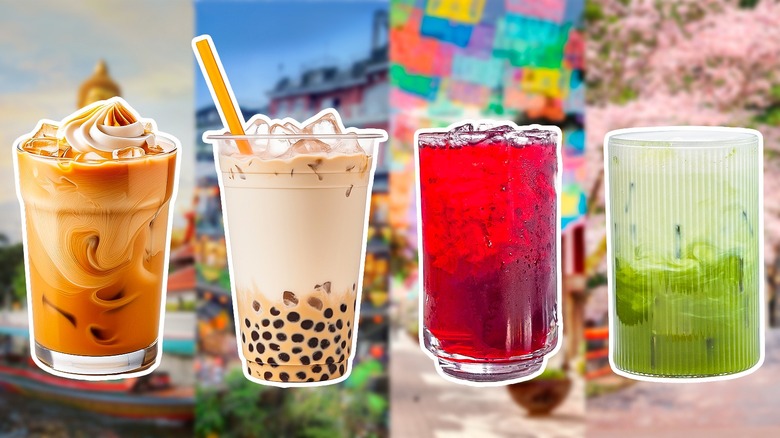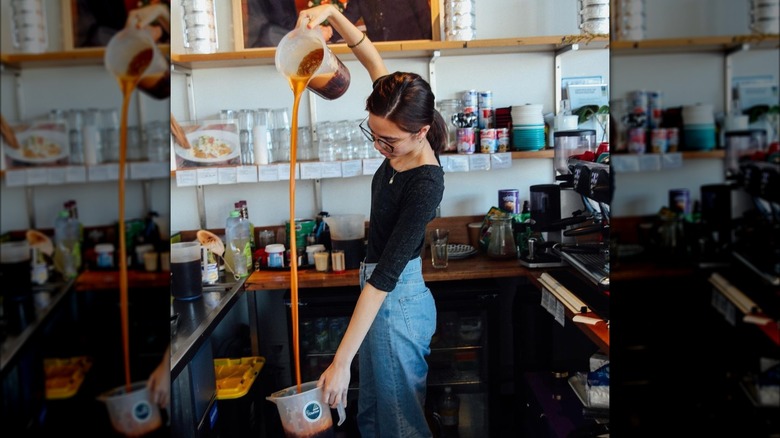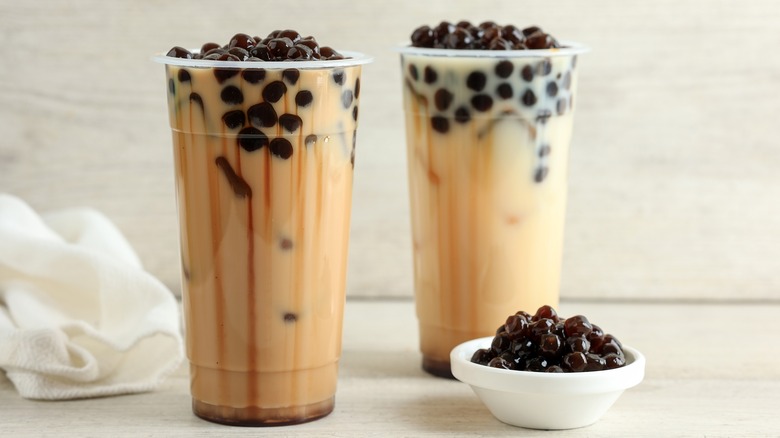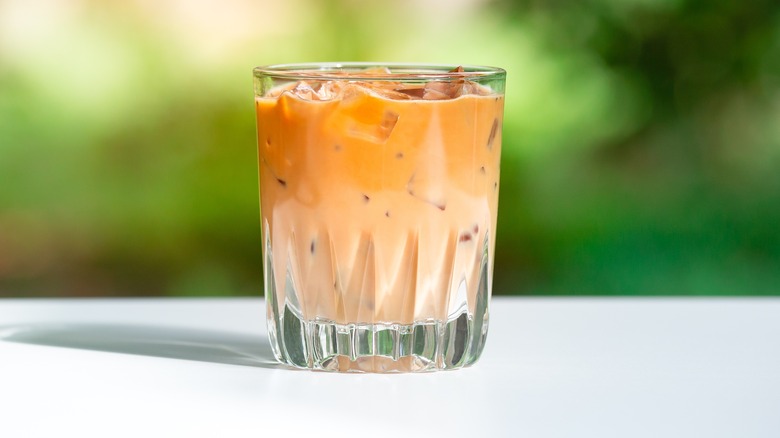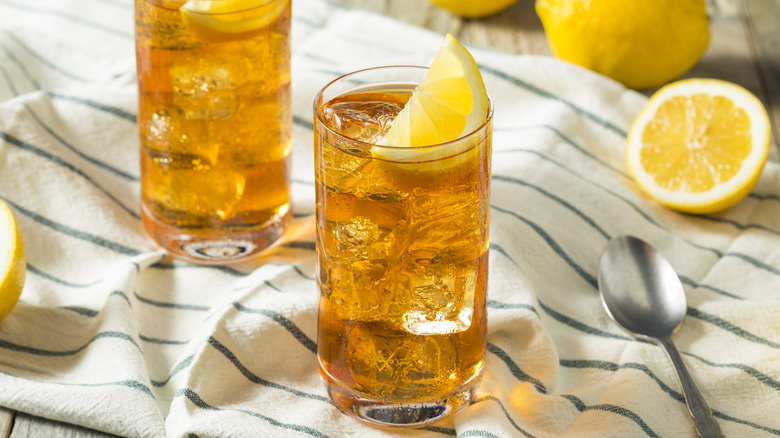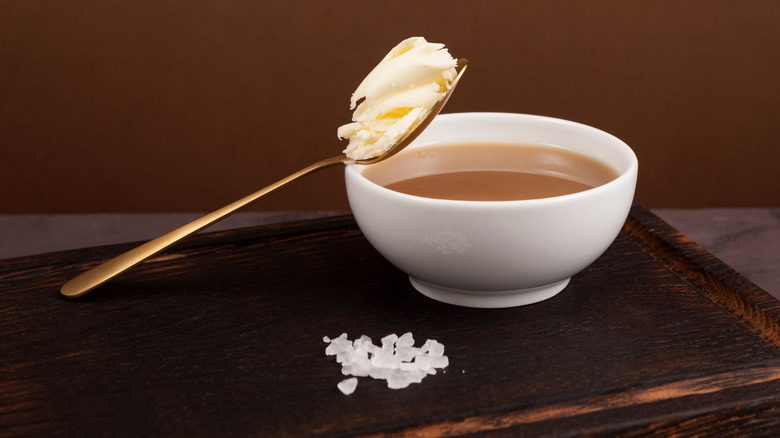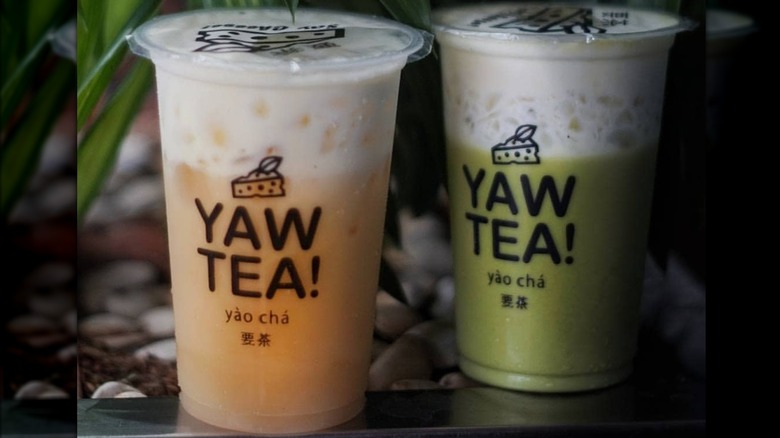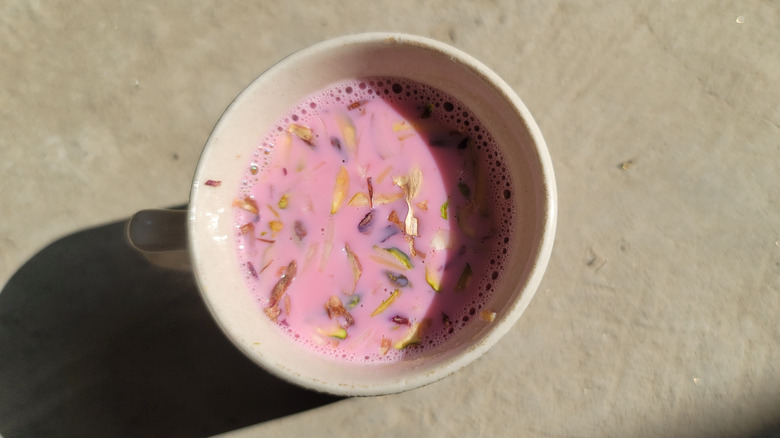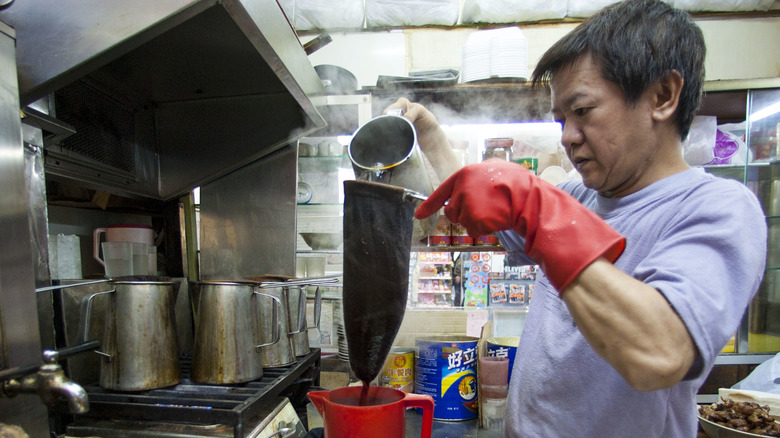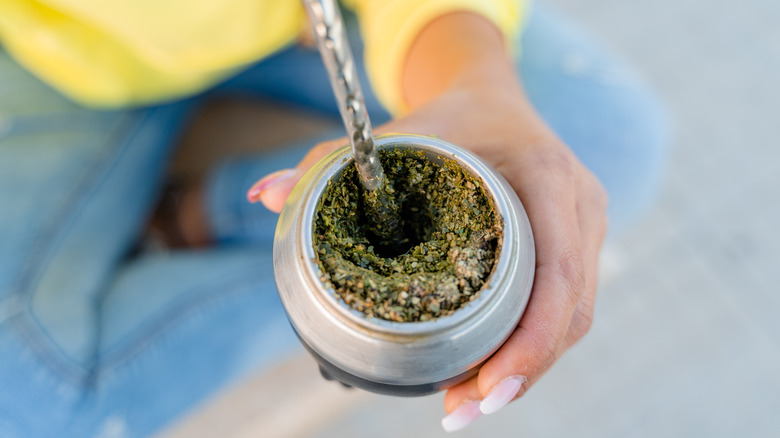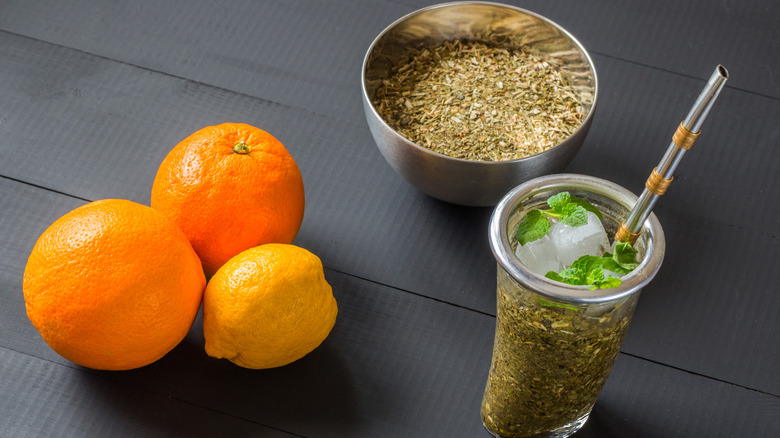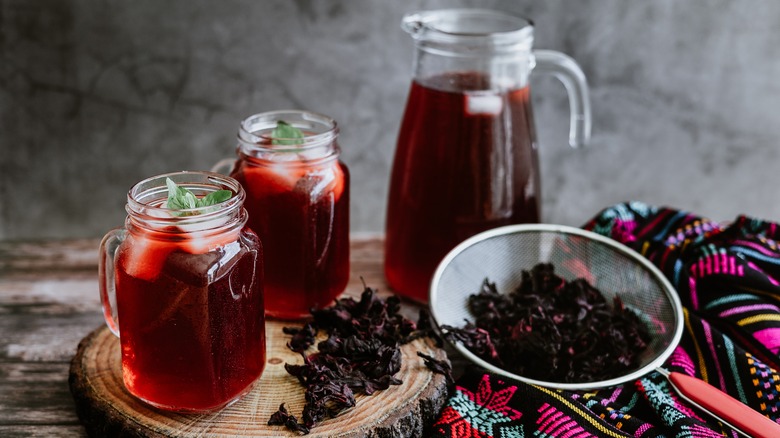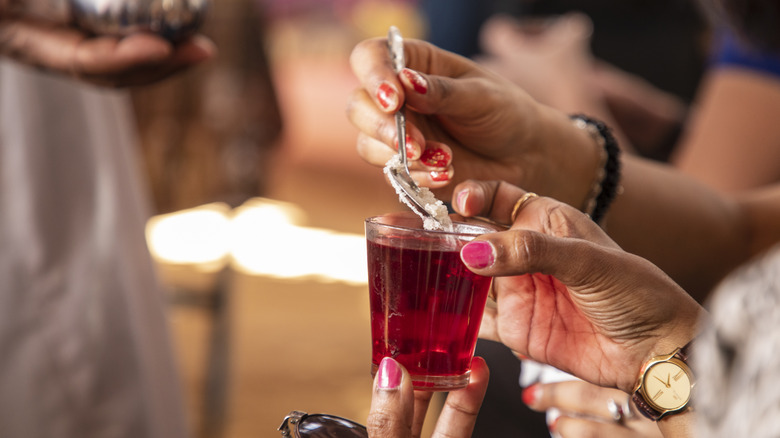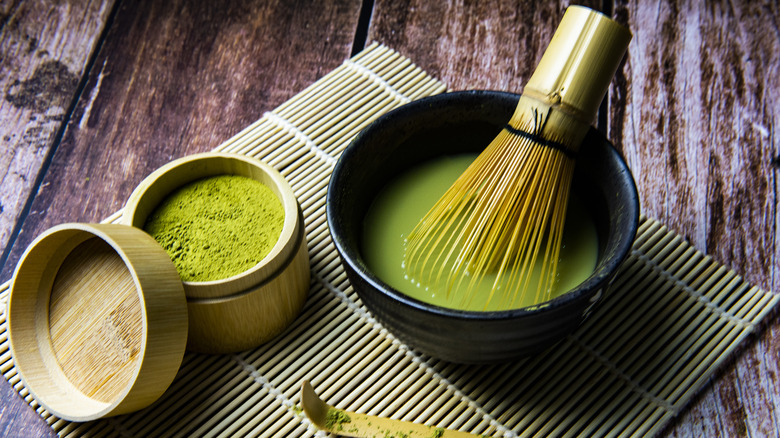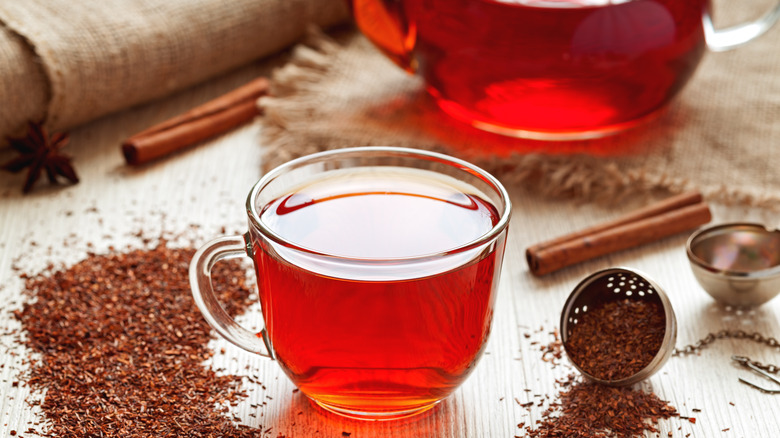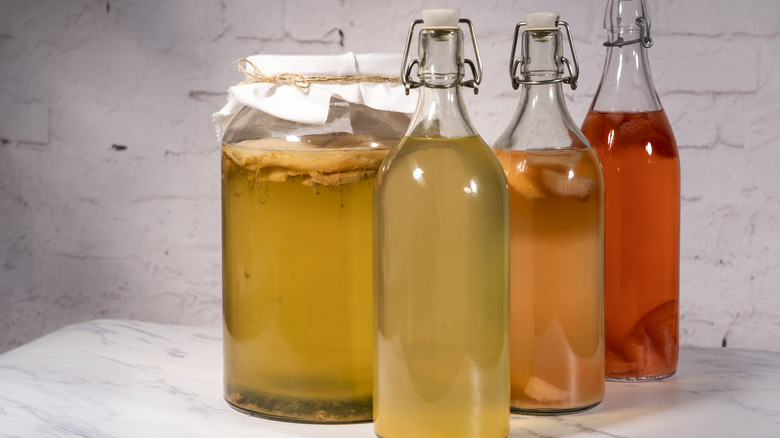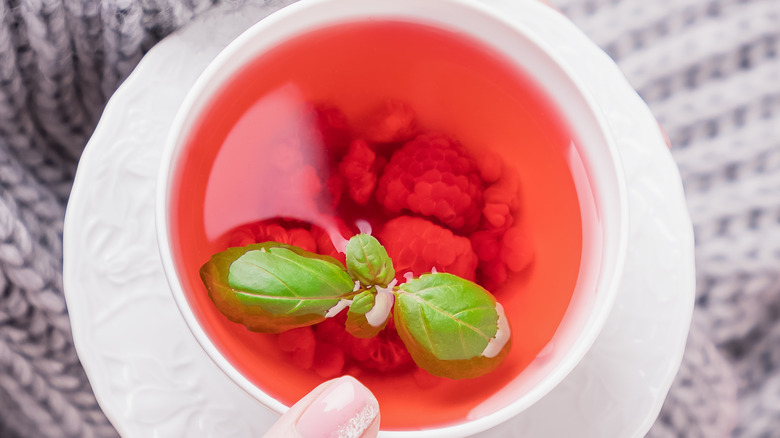16 Tea Drinks From Around The World That You Need To Try
With countless styles and preparations to choose from, tea is the world's most consumed beverage (aside from water). Tea is typically broken down into six categories, and within those there are about 1,500 cultivars. Once you consider the different methods and potential ingredients, the world of tea drinks expands exponentially. Of course, while some international tea delicacies have firmly cemented themselves in the U.S., others aren't as ubiquitous. From popular favorites like bubble tea and matcha to lesser-known beverages like cheese tea and karkade, there are plenty of tea drinks from around the world worth trying.
With some input from Kayla Stavridis (former Starbucks barista and current head of marketing at Barista HQ) and Ashlea J. Russell (a travel writer behind She Roams About, who specializes in Mexican culture), we compiled a selection of the top international tea drinks. After learning some of the intricacies of tea drinks from around the world, you may be inspired to reproduce these beverages from the comfort of your home, or journey to distant lands for an authentic taste. Here are 16 tea drinks from around the world you need to try.
Teh tarik – Malaysia
Whether it's heating the water to specific temperatures, steeping leaves for a precise duration, or pouring the liquid in a certain manner, serving tea often involves rituals. In Malaysia and surrounding Southeast Asian countries, teh tarik focuses on the serving method, utilizing a particular technique to develop a rich and frothy consistency.
Introduced by South Indians during the height of the rubber industry in the late 1800s and early 1900s, the drink eventually took on its own characteristics, becoming a staple of Malaysian culture. Also known as pulled tea, the beverage features a combination of black tea (typically lesser-grade leaves), condensed milk, and sugar. The specifics and measurements are kept under wraps by each tea maker, with the resulting taste being a mix of sweet and earthy aromas.
More important is the craft of pouring the tea between two cups. The increased height and arc of the flow creates extra frothiness while introducing an airy quality that defines the taste. You'll easily find teh tarik at street stands throughout Malaysia, or you can practice pulling tea at home ... though you might want to do it outside.
Boba tea – Taiwan
Boba or bubble tea might be one of the more popular tea drinks found in the U.S. With its rainbow of hues and gummy orbs, it certainly draws attention. Yet it's only been around since the mid-1980s, when it was invented in Taiwan by one of two tea houses. Both houses insist on being the original creator of the beverage, and even went through a legal battle to assert claim. While neither business has proven victorious as of 2024 (nor is there a patent for the product), bubble tea has continued to evolve over the decades.
The original drink consists of a sweet iced black tea thickened with a lactose-free creamer and combined with tapioca pearls (aka boba). The pearls are made with tapioca starch (as well as sweet potato starch, in some cases), brown sugar, and water, then rolled into spheres and boiled. Their consistency is possibly the biggest draw to the beverage, as it features a playful blend of chewy and supple textures. You'll find a wide range of teas as the base, too, such as green or jasmine, as well as variations with a fruit drink.
Cha yen – Thailand
Refreshing iced tea drinks are popular across cultures, and Thailand's version is an absolute treat. Easily identified by its vibrant orange appearance, cha yen is a blend of sweet and spice that typically features a Ceylon black tea base. One origin story suggests workers would reuse tea leaves that had already been steeped to make the beverage, while adding other ingredients to enhance the taste. The drink as it's served today was developed in the 1980s, quickly becoming a favorite beyond the country's borders.
Spices are commonly incorporated into Thai iced tea during the steeping process to give it a robust flavor. Common add-ins include star anise, cinnamon, vanilla bean, cardamom, orange blossom essence, and tamarind, which produces a drink with layered aromas and nuance. Before serving, it's combined with sweetened condensed milk and evaporated milk, then poured over crushed ice for a sweet, creamy, and refreshing finish. While tamarind can provide a bit of its color, the boldest examples often include a few drops of orange food coloring, as well.
Sweet iced tea – U.S.
If you're from the South or have spent any time there, you'll be familiar with sweet iced tea. The sugary concoction is a local favorite, served regularly with or without food. The first known recipe appeared in a late 1800s cookbook, "Housekeeping in Old Virginia," written by Marion Cabell Tyree. It instructed readers to steep green tea in the morning, strain it before dinner, then serve it on ice with a couple spoonfuls of sugar and a splash of lemon juice (to balance the bitterness).
The popularity of sweet iced tea grew during the early 1900s. The refreshing drink was quickly revered, and it became the obvious beverage choice during Prohibition. Meanwhile, black tea came into the picture during World War II, when green tea was no longer accessible, and continues to be the primary base for modern sweet iced tea. By the end of the 20th century, South Carolina's General Assembly determined sweet iced tea to be the state's hospitality beverage, further symbolizing its cultural importance.
Po cha – Tibet
Butter tea might sound like a component of a keto diet, but its origins are far more traditional. The beverage stems from Tibet, and the butter comes from yaks. The hearty drink is commonly made by brewing fermented black tea (pu'erh) with salt, then combining it with yak butter, toasted barley, and milk curds. The mixture leans savory and tastes almost like a rich, salty soup.
More substantial than a simple cup of black tea, po cha has long been consumed in the Tibetan plateaus given the region's harsh climate and high altitudes. Thanks to the richness of the fat and the extra bulk from the barley, it's a potent sidekick to ward off any chill or symptoms (with the added calories providing more sustenance, as well). Additionally, since yak butter is pricey and not always easy to obtain, a similar recipe with yak milk is commonly substituted.
Cheese tea – Taiwan
Considering milk and cream are precursors to cheese, cheese tea is not that far-fetched. Of course, this tea drink also makes a lot more sense if you think of cheesecake rather than a chunk of cheddar. The popular beverage is believed to have originated in night markets in Taiwan in the early 2010s, moving on to China and its surrounding countries before the rest of the world.
To make cheese tea, a combination of icing sugar, soft cream cheese, and milk are whipped together with a pinch of salt, creating a foamy topping for green or black iced tea. You can either serve the creamy mixture on top of the drink, or combine it with the other components. Skip the straw when savoring this drink or you'll compromise the tantalizing texture.
The blend of earthy flavors from the tea and the sweet creamy richness from the cheese topping come together surprisingly well. Simply put, you need to taste this unique drink to truly understand. Although the name might be cause for pause, the beverage is comparable to bubble tea, which gets plenty of love stateside.
Noon chai – India
India is known for its classic masala chai blend of spices and milk, but there are plenty of variations to this staple. Noon chai is one example originating from the province of Kashmir. Also known as pink tea (though the actual translation is salt tea), the drink is easily identified due to its pretty pink hue. It is a traditional component of Kashmiri weddings, symbolizing love and hospitality.
Noon chai consists of green tea, milk, salt, and baking soda, which combined together give the drink its noteworthy color. There are variations of the recipe, but it typically calls for boiling green tea leaves with baking soda, spices (typically star anise, cinnamon, and cardamom), and salt, before simmering it for a while. During this time, the mixture is whisked and beaten — aerating the ingredients and creating the pink hue — before sugar is added to sweeten. Additionally, it's often served with milk and garnishes like pistachios and rose petals.
Hong Kong-style milk tea
Hong Kong-style milk tea isn't just ordinary tea served with milk. In fact, like several other popular tea beverages, it's all about the preparation method. Brewers start by making their signature tea blends with a mixture of different types of black tea leaves. The leaves are steeped in a silk stocking through which the liquid is poured four times, boosting the flavor and color while reducing the bitterness. It's a delicate balance between using a suitable water temperature and pouring the tea the right number of times at the proper height.
This tea drink is served with evaporated milk and sugar or sweetened condensed milk to balance out the astringency. In Hong Kong, the art of making this popular tea is a craft that requires years to master. There are even milk tea brewing competitions to identify these skills, highlighting elements like color, taste, aroma, consistency, balance, and creaminess to determine the perfect cup. Given the precision of this beverage, then, you'll likely want to stick to enjoying it in establishments around Hong Kong, where it's made by people with plenty of practice.
Yerba mate – South America
A staple of Argentina, Paraguay, Uruguay, and southern Brazil, yerba mate has a fascinating history. Its current form likely originated from the native Guarani people, and the beverage is made with leaves from a regional species of holly tree, which produces a bitter, caffeinated herbal tea. The leaves are usually steeped in an individual gourd and sipped through a flattened metal straw (or bombilla).
Yerba mate is earthy and herbaceous, and often serves as a stimulant in place of coffee or other types of caffeinated tea. However, the culture of drinking this tea beverage goes far beyond a caffeine fix. Consuming mate is often a social activity, and people usually pass their gourd around and share the contents with a small group of friends or family. Being invited to drink mate with a local is a cultural rite, in fact, and an important bonding experience in Argentina and other areas of South America.
Tereré – Paraguay
South America is known for yerba mate. But in Paraguay (and occasionally in neighboring countries), it's consumed with a twist. The usually hot tea drink is served cold as tereré ... with a few fruity additions to complement the bitter notes. It's a cool and tangy transition from the hot tea to this chilled variation, and one that's welcome in the warmer months.
Tereré has a longstanding tradition among the Guarani people of Paraguay, who consume it socially and ritually for its purported health and medicinal benefits. It is so ingrained in the culture that it was declared to be an Intangible Cultural Heritage of Humanity by UNESCO in 2020. The tea beverage can be as basic as mate with cold water for a refreshing variation, or something more complex like a blend of mate and lemonade or orange juice.
If you're making tereré at home, it's best to use yerba mate from Paraguay, which is better suited for cold extraction. Furthermore, just like with yerba mate, this tea drink is consumed in a special gourd vessel and sipped through a flattened metal straw.
Agua de jamaica – Mexico
Tea drinks take on many forms, and in Mexico, a popular variation is agua de jamaica. In this case, jamaica refers to the hibiscus flower, not the country. The flavor is tangy and tart, with a range in sweetness depending on the amount of sugar added. At the sugary extreme, agua de jamaica is comparable to punch and other fruity beverages; when it's sweetened more subtly, though, its character is more herbal.
Ashlea J. Russell told Tasting Table she loves agua de jamaica, and described the preparation process: "This bright ruby red Mexican iced tea is made of steeped dried hibiscus flowers, sweetened with sugar, and served over ice." Russell further noted this refreshing and thirst-quenching drink is commonly served at taquerias and local eateries, as it pairs well with food. As a bonus, hibiscus flowers are packed with antioxidants and vitamin C, making this tea drink a healthy addition to your diet.
Karkade – Egypt
Hibiscus flowers have made their way to numerous corners of the world with several regional varieties. In Egypt, hibiscus sabdariffa is the native plant used to make karkade, also known as the tea of the pharaohs. References to it date back to 1550 B.C., when it was consumed by pharaohs for its medicinal properties, such as regulating blood pressure. The tea drink is enjoyed regularly by locals, and often served as a symbol of hospitality. It's also typically present during Ramadan to break the fast.
The beverage is made by steeping dried hibiscus flower petals for varying durations depending on the desired strength. The drink is then sweetened with sugar or honey, and served either hot or (more commonly) cold. With the high temperatures in Egypt, the iced version is particularly refreshing. The contrasting sweet and tart flavors make it a delicious accompaniment to various local foods, several of which also use the flowers for preparation.
Matcha – Japan
By now, matcha culture is firmly cemented in the U.S. However, the beverage originated in Japan courtesy of a Zen Buddhist monk who brought the tea seeds back from China. Its consumption was primarily confined to ceremonial settings for some time, but it's since expanded to be served more casually.
Easily recognized for its bright green color, matcha comes from tea leaves that are grown in the shade. This increases the chlorophyll, or the compound that gives them their green color. Unlike many tea drinks made with the leaves, matcha is made by grounding them into a powder. The powder is then combined with boiling water and whisked (often with a special brush made from bamboo), which creates a frothy and creamy drink. The flavor is mildly nutty, grassy, and herbaceous with a bitter note to round it out.
According to Kayla Stavridis, the antioxidant and vitamin levels are particularly elevated in this drink, as well, since the tea isn't strained. Additionally, while this variety of green tea is comparably high in caffeine, Stavridis stated "it provides sustained energy without the usual jitteriness associated with coffee."
Rooibos – South Africa
Rooibos tea is such a staple of South African culture that many children grow up drinking it in their early years. Of course, the country also exports large amounts of rooibos to dozens of nations worldwide. The herbal tea has a reddish color and an earthy, nutty flavor. Plus, as Kayla Stavridis noted, "Its smooth, natural sweetness and lack of caffeine make it an excellent choice for any time of day." It can be sweetened with honey or sugar, if desired, and drunk either hot or cold.
Aside from its distinctive taste, rooibos is purported to have several health benefits, and was given a Protected Designation of Origin status in 2021. This protects and preserves the quality of the product, while defining its place of origin as South Africa. More specifically, it is only cultivated in the Cederberg region near Cape Town, where the conditions are optimal for its growth. Processing rooibos requires crushing the stems, fermenting them, then leaving them to dry in the sun, which ultimately gives the herb its characteristic color.
Kombucha – China
These days, it seems like a bottle of kombucha is never far away in the U.S., but its popularity extends far beyond recent history. In fact, the lightly fizzy drink is thought to have been around for a couple of millennia, originating during China's Qin Dynasty. Specifics about its journey to modern times are vague, with stories of its consumption occurring in other Asian countries and Europe along the way. Kombucha seems to have been a popular drink among Russian and German soldiers during World War I, for instance, often for its purported health benefits.
Sometimes referred to as the elixir of life, it's clear that kombucha has long been revered. To make kombucha, sweetened tea is fermented with a symbiotic culture of bacteria and yeast (or SCOBY), which causes the characteristic fizz and subtle tang to develop. While black tea is commonly used, other varieties can be substituted for a different taste. The tea beverage can also be flavored — both pre and post fermentation — with fruit juices, purees, herbs, and more, with a quick look at any kombucha display proving the options are virtually endless.
Herbata malinowa – Poland
You might not think of Poland as the source of a tasty pink tea drink, but herbata malinowa is a local favorite. The beverage consists of black tea combined with raspberry syrup, producing a dazzling color and a delightful taste. Raspberry leaf is sometimes added for its offer health benefits, as well, while other ingredients – including apple, rosehip, hibiscus, and elderberry — can also be added to the blend, along with sugar to sweeten.
Tea culture became more prevalent in Poland over the last two centuries. The country is among the highest tea consumers in modern Europe, with people often sipping on simple black tea with lemon. Tea is also enjoyed as a social pastime and alternative to alcohol, though the two drinking cultures occasionally cross over. For example, a boozier variation of herbata malinowa, called herbata góralska, incorporates vodka and rum for a blood-warming beverage.
